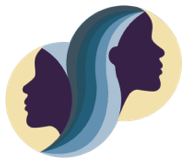
Pictured above, from left, are Joe Scott, David G. Lewis, and Kari Marie Norgaard. Photos by Jack Liu.
On April 25, 2023, CSWS hosted “Native Ecologies,” a panel discussion on Indigenous histories and approaches to fire management, knowledge production, and ecological stewardship.
Held in Lawrence Hall, the event included native panelists Amada Lang, Joe Scott, and David G. Lewis, with sociology and environmental studies Professor Kari Marie Norgaard and moderator Kirby Brown, associate professor of Native American and Indigenous literary and cultural production. Immediately following the panel was the opening reception for the Ghost Forest and Wildfire exhibits in the LaVerne Krause Gallery.
The events were part of “Haunting Ecologies: The Past, Present, and Future of Feminist and Indigenous Approaches to Forest Fire,” a CSWS and UO Environment Initiative partnership.
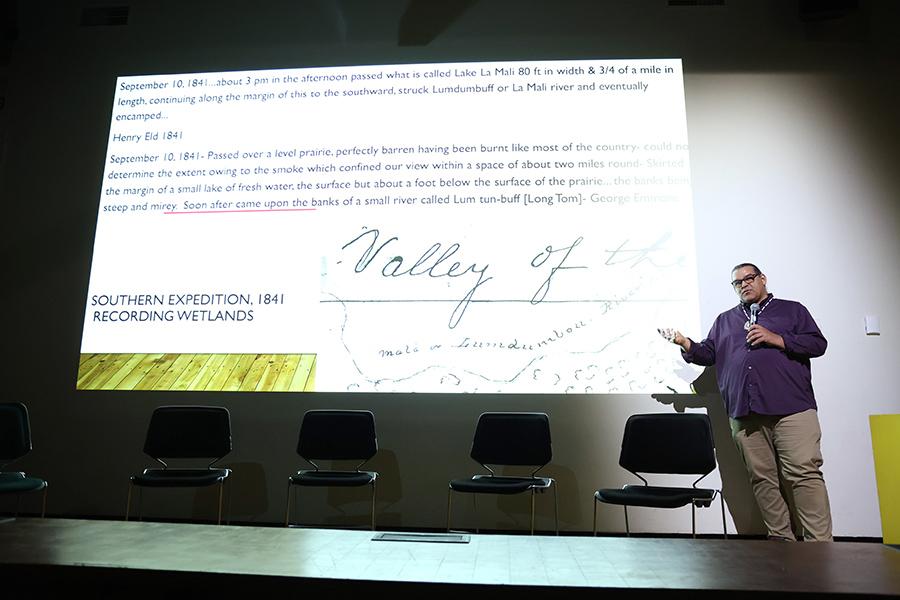
David G. Lewis, PhD, is an OSU Assistant Professor of Anthropology and Ethnic Studies & Indigenous Studies. He is a member of the Grand Ronde Tribe, descended from Takelma, Chinook, Molalla, and Santiam Kalapuya peoples. Lewis opened the panel with a presentation on the role of fire in tribal management of wetlands in the Willamette Valley prior to settler-colonialism. In the late 19th century, European settlers drained the valley’s wetlands to create monocrop farming. “We destroyed a giant ecosystem that was homeland to lots and lots of wildlife, to tribes who utilized it for food, so we’re trying to do something to restore it today,” Lewis said. “Bringing back fire is a great start, but we have to bring the water back too.”
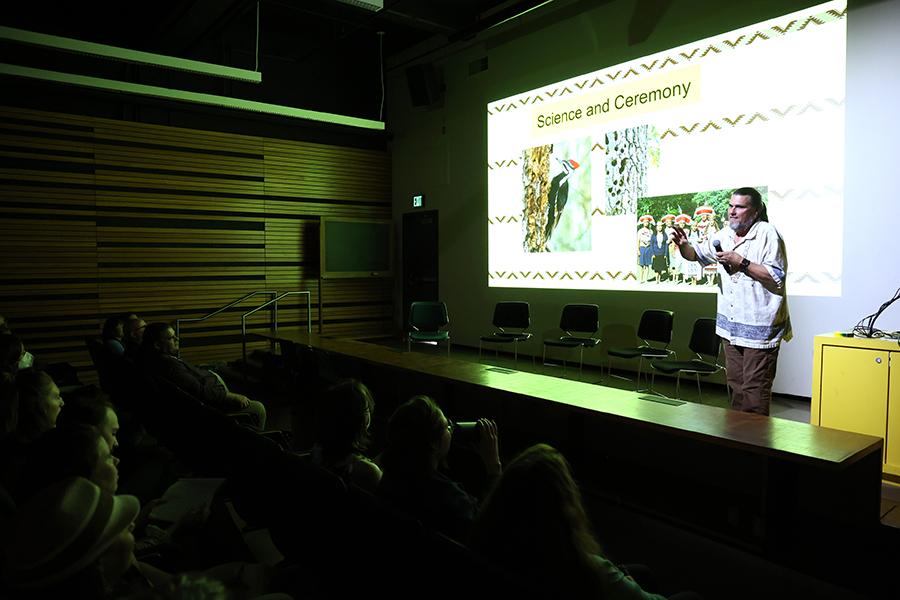
Joe Scott is a member of the Confederated Tribes of Siletz Indians, a descendant of the Rogue River Tribes of Southern Oregon. He currently lives and studies on Kalapuya Illahee as Curriculum Director for the Traditional Ecological Inquiry Program. In his presentation, Scott shared stories of what has been happening today in the realm of cultural fire and the efforts of tribes to restore traditional fire practices. After 175 years of settler colonial fire suppression, he said, we have a situation where massive wildfires destroy communities, human and non-human people, and the land. As a result, “fire becomes a war,” Scott said. “And fire has never been like that. Historically, fire is a tool and companion for making things happen on the land.” Today, regional tribes are completely rewriting the script of what fire can be by implementing cultural fire practices to manage and restore their lands to precolonial states. “It’s overwhelmingly amazing to be a part of these projects and seeing these things coming to life,” he said.
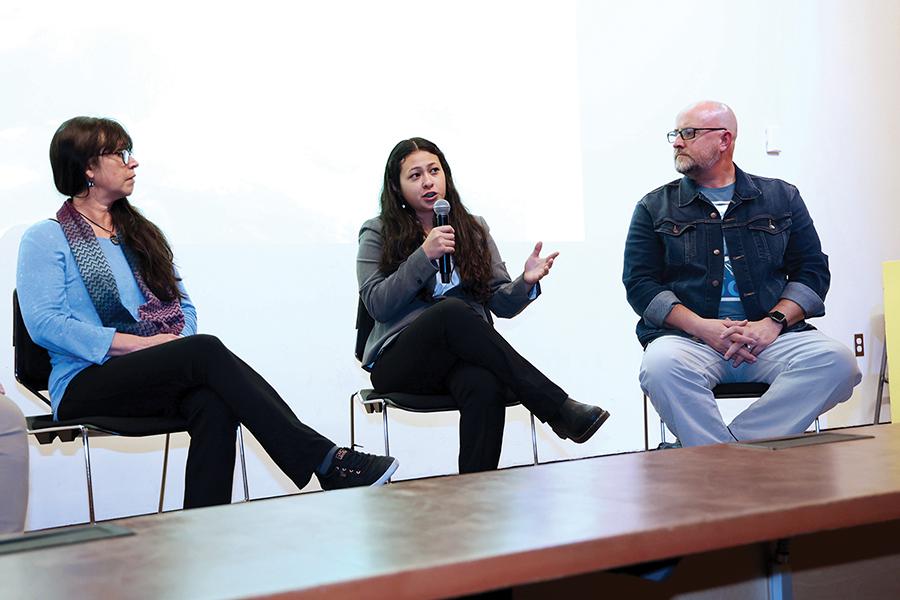
Rounding out the panel was a presentation by Amada Lang and Kari Marie Norgaard. Lang is a Karuk, Wiyot, and Konomihu Shasta Native. She is the Klamath Basin coordinator for Rios to Rivers, providing outdoor adventure education through a traditional ecological knolwedge (TEK) perspective. She described her work with the Women-In-Fire Prescribed Fire Training Exchanges (WTREX) program held in Orleans, California. This is an intensive two-week training only for Indigenous woman from around the globe, where they are able to gather knowledge of cultural burning and prescribed fire to share, practice, and preserve for future generations. “The tribe is really being one the forefront in wanting these ideas and epistemologies to be shown forth,” she said, “and we can’t do it just with allyship as such.”
Kari Marie Norgaard is a non-Native professor of sociology and environmental studies who lives and thinks in Kalapuya lands at University of Oregon. She discussed her work as a consultant for the Northern California Karuk Tribe on tribal environmental policy since 2003. Norgaard is using climate change and awareness of fire and relevance of indigenous burning to try to advance changes in federal and state fire suppression policies. “When I see that smoke we had in 2020 that was so difficult for us to live through, that smoke is the smell of colonialism in my mind,” she said. “We non-native people have been in denial about so many aspects that have happened in this place where we’re living on Kalapuya lands. The negation of colonialism and the return of indigenous epistemologies and ecologies—all of those things are coming back. Yes, it doesn’t stop [wildfires], but it’s work to be done. The return of fire can very much be about healing.”
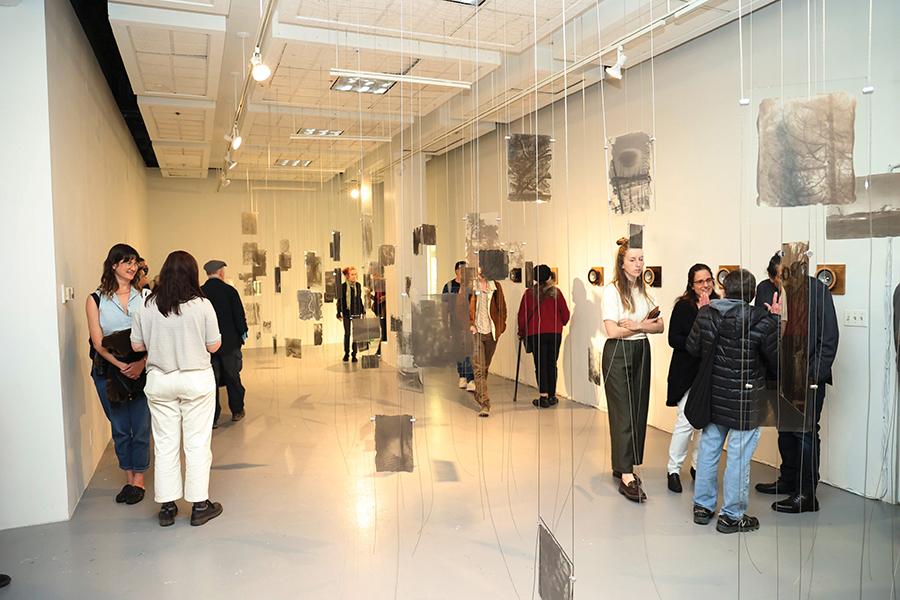
The event concluded with the opening of Eugene photographer Sarah Grew’s exhibit “Ghost Forest,” featuring Jon Bellona’s sound installation “Wildfire.”
Following the devastating 2020 wildfires in Oregon, Grew collected black coals from the fires that she then used through extensive research and experimentation, to create carbon prints of recorded images of the forests themselves. Her process and its resulting prints, with their frilled edges and torn emulsion echo the way natural fire cycles can surmount devastation to provide nutrients to the soil, force a pinecone to disperse its seeds, or shape the landscape, in contrast to the extreme intensity and size of the fires that are now common. The photographs show us the beauty being lost to human negligence and the climate crisis. Printed as lantern slides, the forest memory is held captive on sheets of glass accentuating both the fragility of life and our precarious position. Hung at various heights the viewer is invited to move through the Ghost Forest, witnessing a range of natural elements.
“Wildfire” is a 48-foot-long speaker array that plays back a wave of fire sounds at speeds of actual wildfires. An instructor of audio production in the School of Music and Dance, Jon Bellona hopes the installation will allow viewers to embody the devastating spread of wildfires through an auditory experience. As a sound artist who specializes in digital technologies, Bellona’s music and media explore environmental sustainability, data-body interactivity, digital musical instruments, site-specific sound, and choreographic composition. He is a co-director of Harmonic Laboratory, an interdisciplinary arts collective focused on art and technology collaborations.

